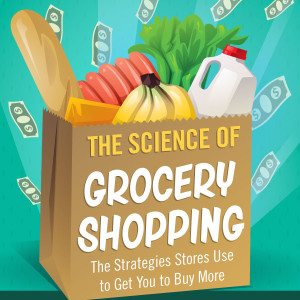The Science of Grocery Shopping: Why You Buy More
 /div>
/div>
The Science of Grocery Shopping: The Strategies Stores Use to Get You to Buy More
Even for people on a strict budget, impulse buys are still a part of the grocery shopping experience. But are those purchases really the result of the sudden “urge to splurge” or, rather, the end result of a carefully crafted marketing plan aimed at you and your wallet? Supermarkets are using science to get you to buy. Let’s look at the ways marketers target you in the grocery store.Your Brain and Shopping
Our senses play a big part in how and why we shop. Bright color on signs, the smell of fresh bread from the in-store bakers.But shopping also can release the brain chemical known as dopamine, which is associated with feelings of pleasure or satisfaction.
That combination of effects on the brain is powerful and hard for most of us to resist.
$638 billion
Total supermarket sales in 2014 (2)
$29.90
Average supermarket sale per customer transaction in 2014
1.5
Average number of trips consumers make to the supermarket per week, 2015
42,214
Average number of items carried by supermarkets in 2014
Shopping by Design
Using information from focus groups, sales data and basic psychology, retail specialists have created a layout for supermarkets that is specifically designed to get you to buy more.(3)The general layout
Fresh produce
Flowers, fruits and vegetables are often placed at the front of the store. The bright colors and smells are designed to put you in a happy mood as soon as you enter, the better to put you in the shopping mood.
Bakery
The bakery section is also generally near the front of the store. The smell of fresh baked goods can make shoppers hungry and get them to buy more.
Meat, dairy sections
Retail specialists place the meat and dairy sections at the back of the store to force shoppers to travel through fully stocked aisles to get there.
End caps
End caps are the sections at the ends of aisles that are stocked with specific goods. Manufactures pay more to have their products placed here but they see a high return. The positioning makes their products seem higher in prestige to consumers.
On the shelves (4)
Even the positioning of items on shelves is designed to maximize the odds you’ll pick up certain products.
Top
Local and gourmet brands are generally placed here.
Middle
The “bulls-eye” zone. This section generally falls right in the shoppers’ line of sight. Leading/best selling brands are placed here and some supermarkets offer this position to manufacturers for an additional fee.
Bottom
Store brands, bulk and generic products are placed here. Retailers know smart shoppers will look for a bargain no matter where it’s placed on the shelf so they don’t waste prime space on these products.
Kids
Since kids often influence shopping habits, grocers put products geared toward them at their eye level.
Other ways supermarkets target consumers: (5)
Bigger shopping carts – proven to get you to buy more.
Narrower checkout lanes – making it harder to get rid of products you decided you don’t need.
Music – slower tunes played over the loudspeaker get you in a lingering mood so you shop longer.
Modern times
80%
Percentage of food sold to consumers by supermarkets or supercenters (Target, Walmart) (6)
28%
Percentage of grocery shopper who said that receiving an in-store coupon influenced their purchases.(7)
235%
Percentage increase in grocery shoppers downloading a food or beverage app since 2010(7)
Becoming a Smart Shopper
While retail marketing is often based on psychology, smart shoppers can counter their efforts by taking a few simple steps. (8, 9, 10)- Don’t shop when you’re hungry. Research has shown that hungry shoppers spend more and buy more high-calorie foods.
- Pre-prepared food (such as pre-chopped fruit, cheese, etc.) may look like a convenience, but the price can represent an up to 600 percent mark-up.
- Make a shopping list and stick to it. Also, know your store’s layout so you can go directly to the items you need.
- Use only cash or debit cards for purchases. Having a financial limit prevents you from making too many impulse buys.
- Be careful shopping in new places. The excitement of shopping in a new place tends to make you spend more or buy things you don’t need.
 Sources:
1. http://www.economist.com
2. http://www.fmi.org
3. http://www.realsimple.com
4. http://online.notredamecollege.edu
5. http://www.rd.com
6. http://eatocracy.cnn.com
7. http://www.mjrcg.com
8. http://www.livescience.com
9. http://www.wsj.com
10. http://www.cbsnews.com
Sources:
1. http://www.economist.com
2. http://www.fmi.org
3. http://www.realsimple.com
4. http://online.notredamecollege.edu
5. http://www.rd.com
6. http://eatocracy.cnn.com
7. http://www.mjrcg.com
8. http://www.livescience.com
9. http://www.wsj.com
10. http://www.cbsnews.com
